List of Authors
>>About this blog
Recent blog post
|
[Mr.Chuo-ku]
Nov. 26, 2013 09:00
Mr. Mikasa Kaikan in Ginza, Chuo-ku. It has a history and is famous for its delicious food, so I think many people know it.
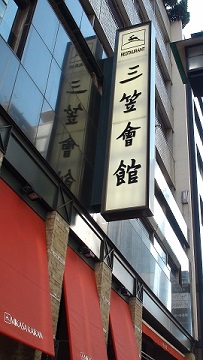
It seems that this Mikasa Kaikan provided the first fried chicken at the restaurant.
According to the website of the Japan Karaage Association, "Modern Karaage" appeared on the restaurant menu around 1932 in the predecessor of the current Mikasa Kaikan Co., Ltd. (Ginza 5-chome, Tokyo). That's it. "
Examples in the menu table of Mikasa Kaikan↓
Fried chicken with fried sesame salt and mustard.
A gem that is polished with a secret sauce and a technique that has been handed down.
3 ¥600 5 ¥1,000
Mikasa Hall
http://www.mikasakaikan.co.jp/restaurant/yoshoku/ginzayoshoku-mikasakaikan/menu
Japan 'KARAAGE' Association
http://karaage.ne.jp/whats/2011/01/karaage-rekishi.html
[Sam]
Nov. 25, 2013 09:57
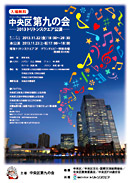 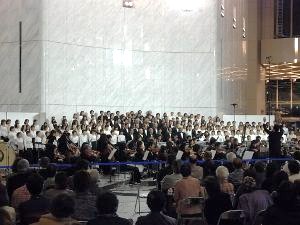
From 17:00 to 18:00 on November 23, the annual “Chuo-ku Ninth Party Harumi Triton Square Performance” was held at the Grand Lobby special venue on the 2nd floor of Harumi Triton Square.
Following the open rehearsal on the previous day, this performance will be held today.
The Chuo-ku Ninth Association was formed in 2007 by residents and working in Chuo-ku, and currently has about 200 people of all ages, from their teens to 80s, and is composed of the Chuo-ku Symphony Orchestra, which consists of about 65 members established in 1994.
Following the chorus of the first part of the Chuo Ward Arima Elementary School Choir, the chorus of the Chuo Ward Tsukuda Junior High School Chorus, and the ninth edition of Chuo-ku "Oedo Nihonbashi", the second part of the orchestra, four solo singers and four parts By mixed chorus, Beethoven composed symphony No. 9-2 short-tone work 125 "Sing" is higher than the fourth.
[Apricot peony]
Nov. 20, 2013 09:00
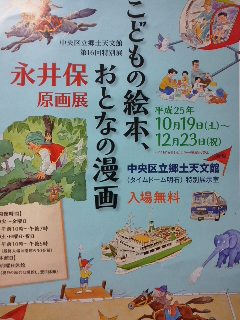 From October 19 to December 23, the Local Tenmonkan (Time Dome Akashi) will hold an original painting exhibition by Tamotsu Nagai, a painter from Chuo-ku, entitled "Children's Picture Book, Adult Manga". . From October 19 to December 23, the Local Tenmonkan (Time Dome Akashi) will hold an original painting exhibition by Tamotsu Nagai, a painter from Chuo-ku, entitled "Children's Picture Book, Adult Manga". .
Tamotsu Nagai was born in Nihonbashi in 1915, and was widely active in picture books such as manga and Kinder Books in the early Showa era, as well as people and landscape sketches in "Monthly Nihonbashi" and "Ginza Hundred Points". He died at the age of 88 in 2004.
More than 4,000 works and favorite items were donated by the bereaved family, and this time the special exhibition was held.
In connection with the special exhibition, there were public lectures and lectures. On November 2, a symposium called "Tamotsu Nagai's View Landscape" was held as a Chuo Ward College Open College.
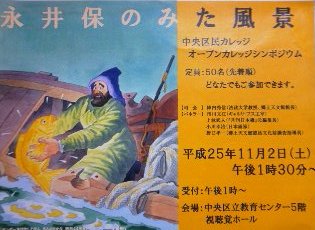
Moderators are Professor Hidenobu Jinnai, professor of Hosei University and director of the local astronomy, panelists are Fumie Ichikawa, president of Galli Puss, Taketo Kamibayashi, former editor-in-chief of "Monthly Nihonbashi", Koji Ogawa, Japanese painter, and Local Tenmonkan General Cultural Property Research Instructor Koichi Noguchi.
At the beginning, Dr. Noguchi introduced the footprints of Tamotsu Nagai, and Fumie Ichikawa, who had a personal friendship, showed his personality and various episodes.
Taketo Kamibayashi talked about Tamotsu Nagai and Nihonbashi, and Koji Ogawa was a painter and talked about how Chuo-ku was painted since the Edo period.
On the way, various episodes were also shown by the bereaved family who came to the audience and the owner of Taimeiken, who always asked for catering for the opening party of the solo exhibition.
The stylish atmosphere of Nihonbashi during the time when there was a fish shore, and the personality loved and respected by many people seemed to come to life in the story of the people of the edge.
From the audience, the paintings of the war era, which were not talked much much, are also depicted in detail with equipment that was not revealed as military secrets, and the viewpoint as a painter is truly wonderful and historically valuable. , And the panelists and their bereaved families were surprised.
The exhibition I saw after listening to everyone's fun story seemed to be a warm person of Tamotsu Nagai and the scenery of Nihonbashi and Ginza in the Taisho era and Showa era revived, so I was able to enjoy it very much.
The special exhibition "Children's Picture Book, Adult Manga-Tamotsu Nagai Original Painting Exhibition" will be held until December 23.
Admission is free.
If you have time, please come and visit us.
For more information, please check here. → special exhibition "Children's Picture Book, Adult Manga-Tamotsu Nagai Original Painting Exhibition"
[Akira Makibuchi / Sharakusai]
Nov. 19, 2013 09:00
"Autumn Chuo-ku History Walk 2013-Walking the History of the Old Nikko Kaido-(1st)" was held on the afternoon of November 16 (Saturday) with the blessings of Koharu weather. This historical walk visits the Nikko Kaido, which laid the foundation for the prosperity of Edo, from Nihonbashi to the site of Asakusa Gomon. On the first day, we walked from Nihonbashi to the ruins of Kodemmacho prison. The recruitment of participants was recruited in the November 1 issue of the "News of the Ward" and was sponsored and implemented by the "Chuo-ku Cultural Properties Supporters Association", a town walking volunteer guide group.
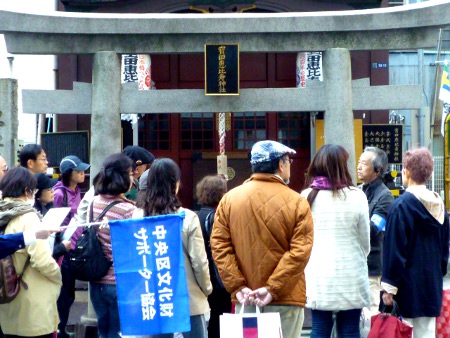 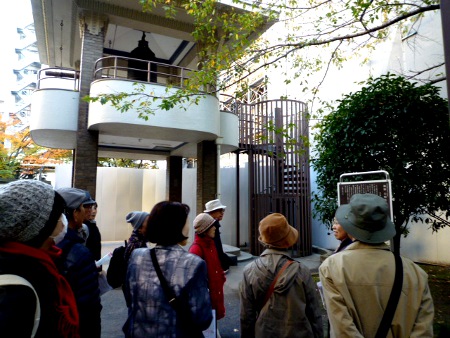
The number of participants gathered in front of Nihonbashi Mitsui Tower reached 30 people and departed in two groups. From Nihonbashi, the starting point of Gokaido, walk along the site of the Nihonbashi Fish Market. The area where long-established stores from the Edo period are lined up still tells the history. Former Honmachi-dori is where the town planning of Edo began. Three old town mansions were set up and the town administration was carried out. Historic sites remain around Edo-dori St., parallel to the old Nikko Kaido, such as the ruins of Juken stores, the ruins of Nagasakiya, and the ruins of Bell Bell Tower in Kokumachi.
After crossing Showa-dori, you will enter Otemmacho. Takarada Ebisu Shrine, known for Bettara City (left photo), and the ruins of Magome Kanyu Yashiki in the first village headman that ruled this area, have a long history. Ise Matsuzaka merchants gathered on the former Nikko Kaido, which is now called "Daidenma Honcho-dori St.", and flourished as the best cotton shop wholesale district in Edo. The remnants of the highway are engraved on the stone monument of the old Nikko Highway.
The whole picture of the Temmacho prison is a model inside Jushi Square, which is the town corner exhibition hall in Chuo-ku, where you can check the layout of the building and the structure of the prison. In Jisshi Park, there is a monument to the end of Yoshida Shoin and a bell of Kokumachi (pictured right) that has been handed down 300 years ago to this day. A two-hour historical walk has been completed here.
The second event will be held on Saturday, November 30 from Jisshi Park to the site of Asakusa Gomon as a continuation of the old Nikko Kaido history walk (application for participation has been closed). @ Akira Makibuchi
[Sam]
Nov. 8, 2013 09:00
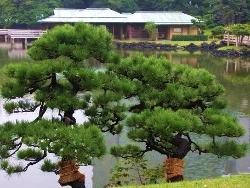 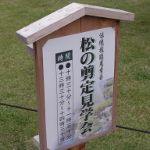 On November 4th, at the site of the Hamarikyu Onshi Garden Yan Liao Hall, "I will show you! This technique-traditional skill "Pine Pruning" tour was held. On November 4th, at the site of the Hamarikyu Onshi Garden Yan Liao Hall, "I will show you! This technique-traditional skill "Pine Pruning" tour was held.
(10:30~11:30、13:30~14:30)
Among the annual pine management, the main ones are "green picking" in spring and "branching / pruning / old leaf removal (rubbing)" in autumn to winter.
In addition, there are “commo roll”, “snow hanging”, and “commo removal” mainly in winter.
In this "pruning", select the main branches, take into account the balance between the upper and lower branches, cut the standing branches, upside down branches, and entangled branches, and consider the shape two to three years later, It leaves about 3 to 5 buds in the size, adjusts the tree shape, improves the sunshine, rain, and winds necessary for growth, and observes the situation with commentary by garden staff.
In addition, Matsumari (Matsukasa) is a cause of weakening of the tree, so it is better to take it if found.
About 600 trees are planted in Japanese black pine alone, making it difficult to care for.
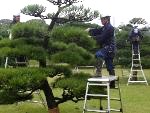 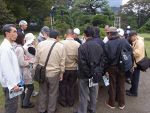 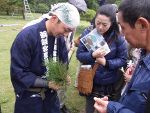
[Sam]
Nov. 7, 2013 09:00
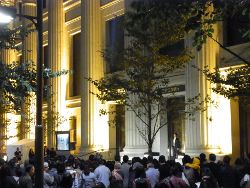 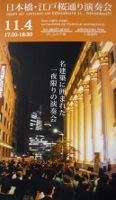 On November 4th, the fifth Nihonbashi-Edo Sakura-dori St. concert was held at Edo Sakura-dori St., lined with historical buildings, along with the main building of the Bank of Japan, Mitsui Main Building, and the Mitsukoshi Nihonbashi Main Store, a designated Historic buildings. (17:30~18:30) On November 4th, the fifth Nihonbashi-Edo Sakura-dori St. concert was held at Edo Sakura-dori St., lined with historical buildings, along with the main building of the Bank of Japan, Mitsui Main Building, and the Mitsukoshi Nihonbashi Main Store, a designated Historic buildings. (17:30~18:30)
This time, it was held as part of the "Open Architecture" linked project "Chuo-ku Marugoto Museum", and while the magnificent columns of the Mitsui Main Building were lit up, Italian tenor Stefano Rodora's Italian song The singing voice echoed, and the end ended with Oai chanting of "Furusato".
✎In "Open Architecture", the splendor of towns and buildings is considered to actually visit and experience the rich atmosphere of the space, and the essence of music to further enhance the appeal of the space, Since the first event, we have been working on a concert set in buildings with the aim of making people feel.
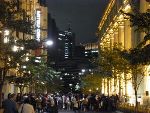 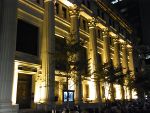 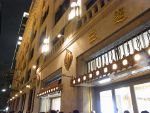
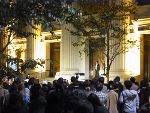 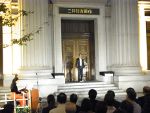 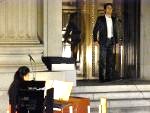
1
|
Links
|



 From October 19 to December 23, the Local Tenmonkan (Time Dome Akashi) will hold an original painting exhibition by Tamotsu Nagai, a painter from Chuo-ku, entitled "Children's Picture Book, Adult Manga". .
From October 19 to December 23, the Local Tenmonkan (Time Dome Akashi) will hold an original painting exhibition by Tamotsu Nagai, a painter from Chuo-ku, entitled "Children's Picture Book, Adult Manga". .

